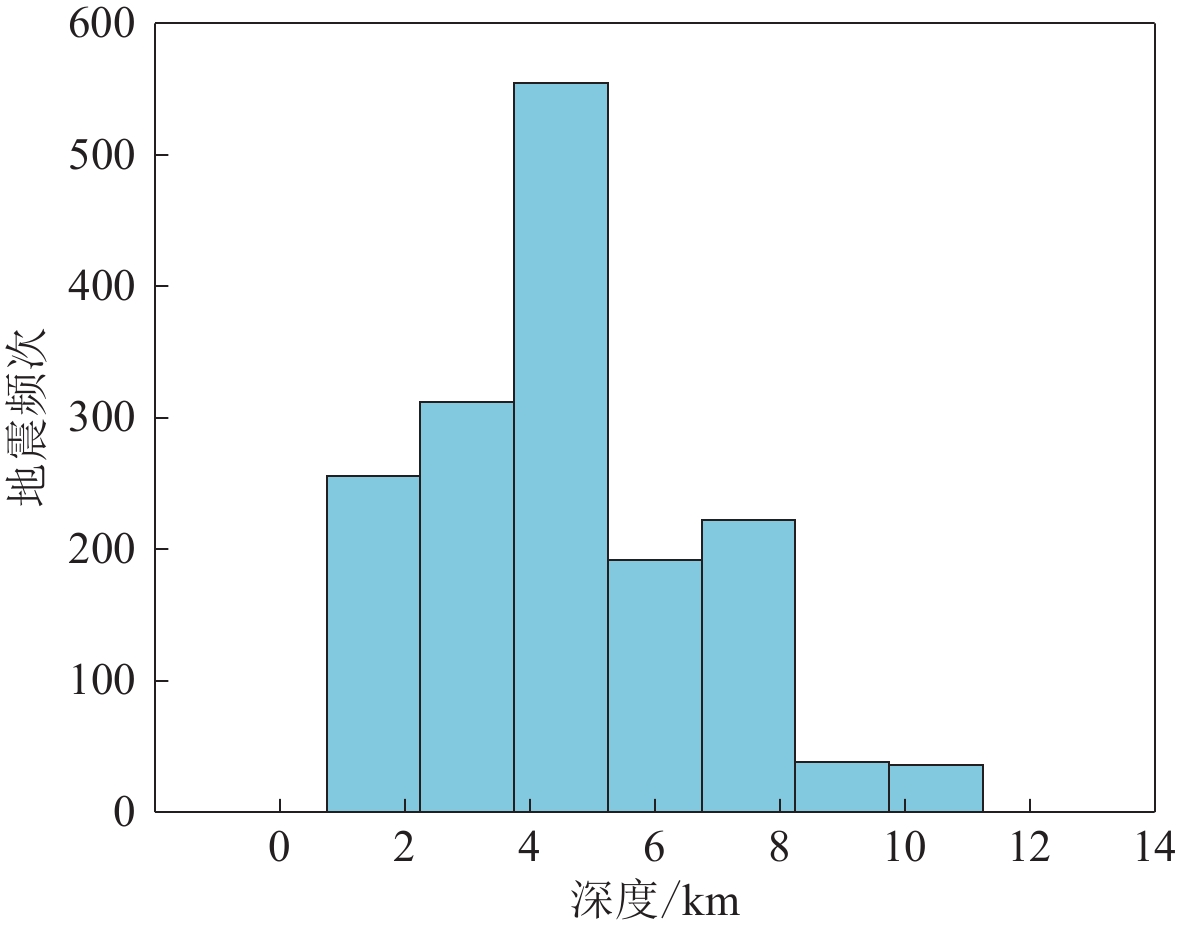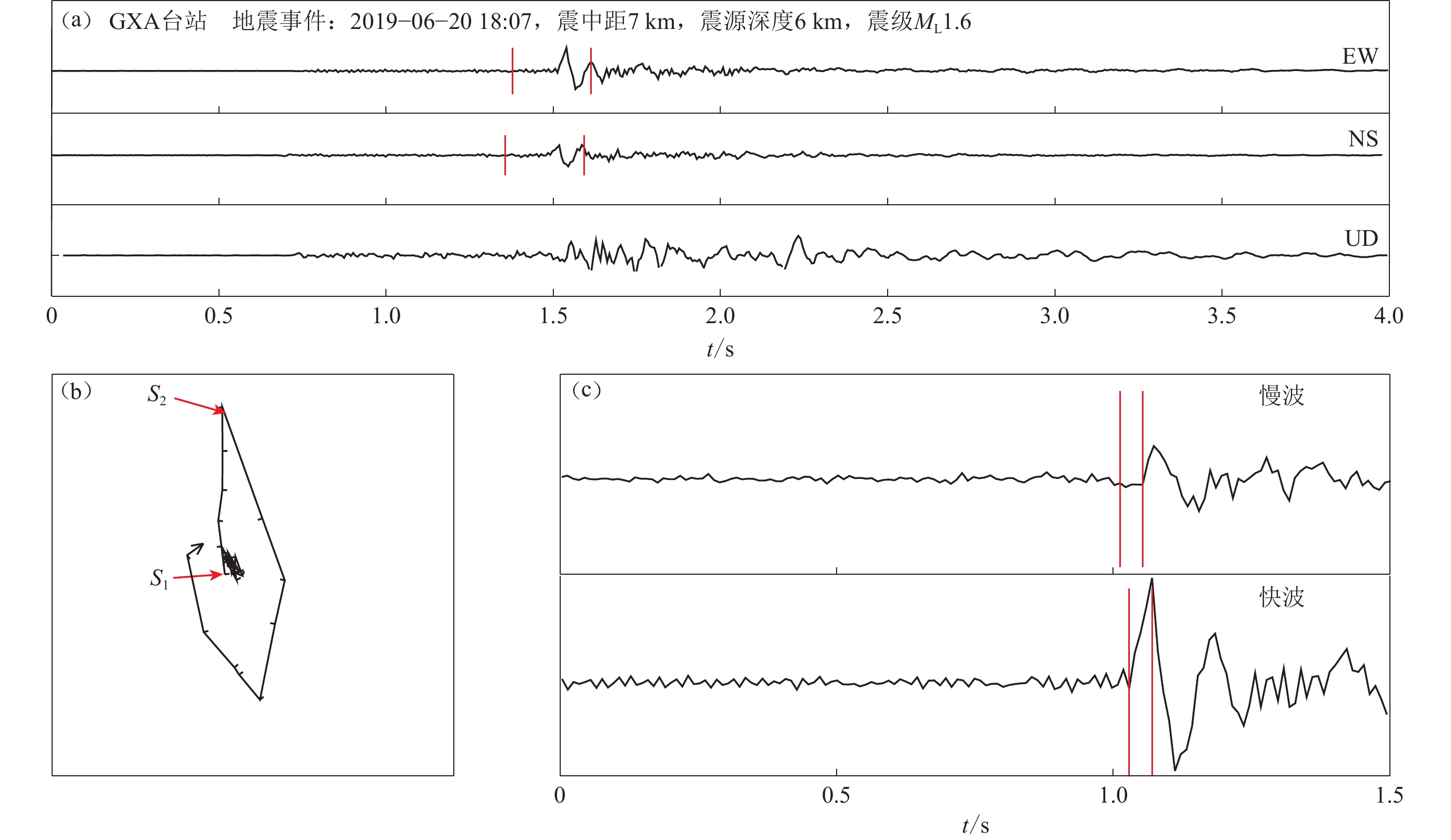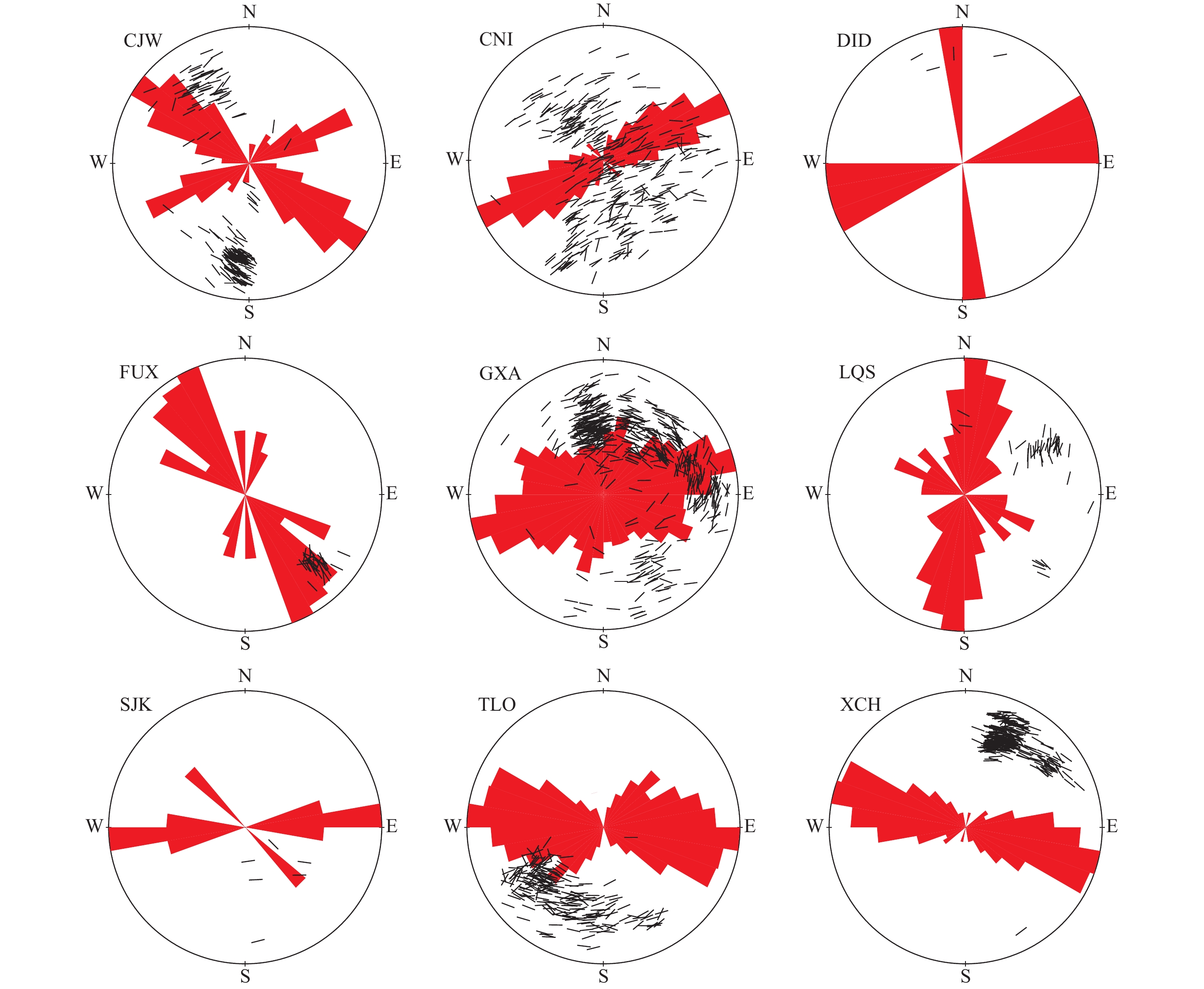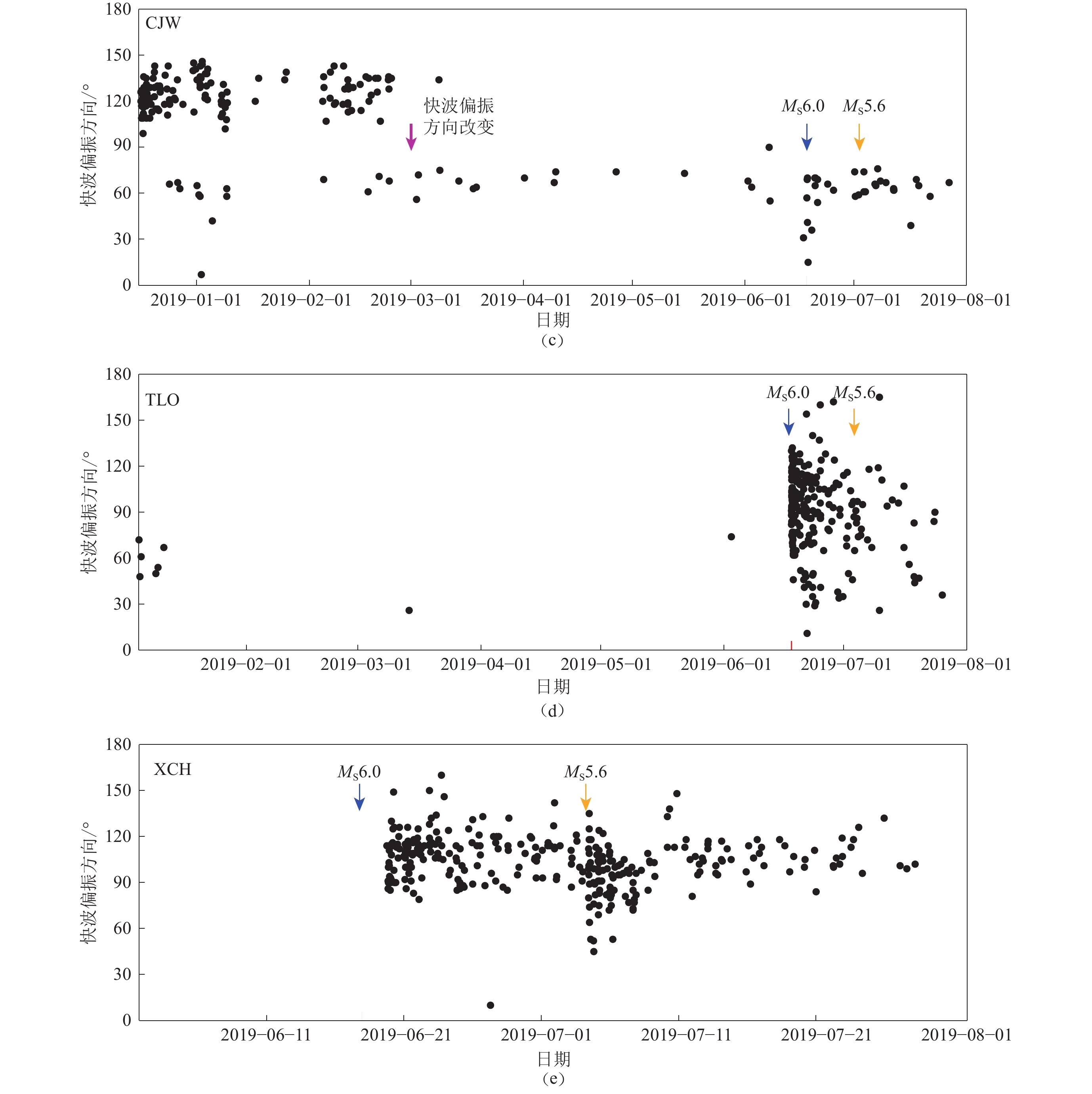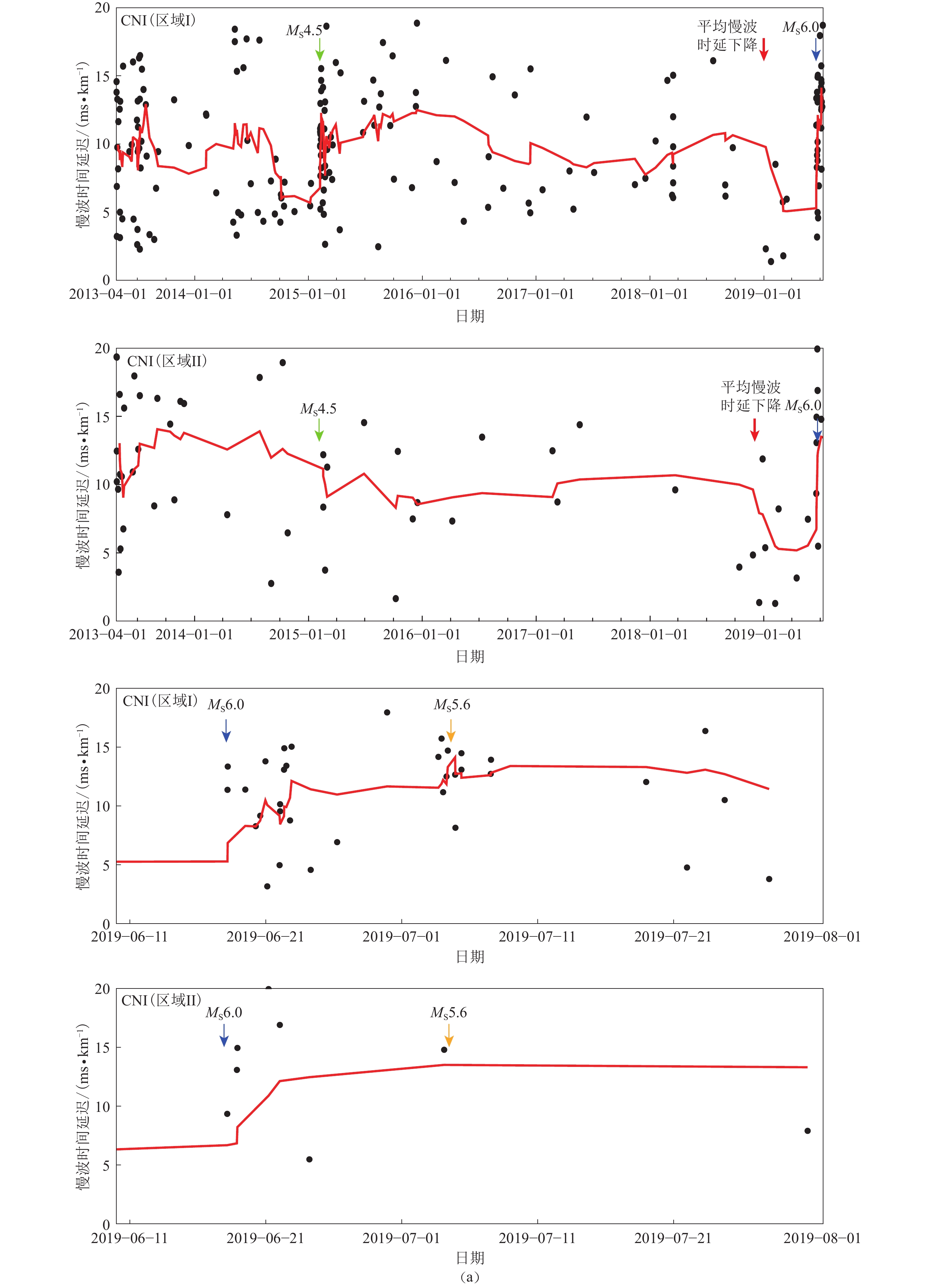Variation characteristic of S-wave splitting on the 2019 Changning MS6.0 earthquake sequence,Sichuan
-
摘要: 本文采用质点运动判别与偏振分析相结合的方法对2019年四川长宁MS6.0地震震源区10个台站于2013年4月25日至2019年7月31日记录到的波形数据进行S波分裂参数测定,其中9个台站获取4条以上有效S波分裂参数。结果表明,震源区各台站的S波分裂参数不仅在空间上存在分区特征,还会随时间发生改变。快波偏振方向在空间上的分区特征大体为:位于震源区东南段的三个台站的快波偏振优势方向主要为NE向,与震源区东南段的主压应力方向基本一致;位于研究区西北段的台站,其快波偏振优势方向为近EW向,与震源区西北段的主压应力方向基本一致。但由于受到震源区地壳应力和复杂构造的共同影响,CJW,GXA和LQS三个台站都有两个快波偏振优势方向。快波偏振方向随时间的变化为:主震后各台站的快波偏振方向都出现离散度增大而后又逐渐趋于一致的现象;CJW台的快波偏振方向在主震前三个月发生了改变,体现了孕震过程中随着应力的不断积累,其各向异性特征由主要受构造控制转变为受应力控制。各台站的归一化慢波时间延迟随台站距主震和余震密集区距离的增加而减小,反映了长宁地震孕震过程中余震密集区的应力积累和释放明显强于周边区域。此外,主震发生前6个月左右CNI台的慢波时间延迟出现明显下降,地震发生后又迅速上升,反映出长宁地震震前的应力积累以及震后应力突然释放使上地壳中微裂隙的几何形态发生了改变。
-
关键词:
- 2019年长宁MS6.0地震 /
- S波分裂 /
- 快波偏振方向 /
- 慢波时间延迟 /
- 地壳各向异性
Abstract: In this paper, the S-wave splitting parameters of the waveform data recorded at 10 stations in the source area of the 2019 Changning MS6.0 earthquake, Sichuan, from April 25, 2013 to July 31, 2019 were measured by the particle motion discriminant method combined with the polarization analysis method. More than four effective S-wave splitting parameters are obtained at nine stations. The results show that the S-wave splitting parameters at the stations in the studied region are characterized by partition in space and variation over time. The characteristics of fast wave polarization direction in space are as follows: the predominant polarization direction of fast S-wave at three stations in the southeastern source area of the Changning earthquake is in the direction of NE, which is consistent with direction of regional principal compressive stress in the southeastern source area. In the northwestern source area, the predominant polarization directions of fast S-wave, nearly EW, is consistent with the directions of regional principal compressive stress in the northwestern source area. Due to the combining effect of crustal stress and complex fault structure, the three stations CJW, GXA and LQS all have two predominant polarization directions of fast S-wave. The polarization directions of fast S-wave change with time as follows: After the main shock, the polarization directions of fast S-wave at each station gradually tended to be convergence after the dispersion increases; the polarization directions of fast S-waves at the station CJW changed three months before the main shock, indicating that with the accumulation of the stress during the seismogenic process, the anisotropic characteristics at the station CJW are controlled mainly by stress instead of structure. As for the temporal distribution, the average normalized delay time of slow S-wave at each station decreased as the distance increasing from the main shock and aftershock dense area to stations, reflecting the stronger accumulation and releasing of stress during seismogenic process in the aftershock dense area. In addition, the normalized delay time of slow S-wave at the station CNI decreased significantly about six months before the main shock, and increased rapidly after the main shock, suggesting the accumulation of stress before the earthquake and the abrupt release of stress after the earthquake lead to the change in geometry of the micro-cracks in upper crust. -
-
图 3 GXA台站记录的S波分裂分析示例
(a) 三分向原始地震图,两竖线间的波段用于绘制质点偏振图;(b) 经过旋转的质点振动图,S1为快波到时,S2为慢波到时;(c) 两水平分向的波形经旋转至快、慢波方向的地震图,两竖线代表快、慢波到时;图中振幅值已归一化处理
Figure 3. Example of S wave splitting analysis for the records at the stations GXA
(a) Three-component records of original seismic waveforms,and the S-waveform between two vertical short lines is used to plot the particle polarization figure;(b) The rotated particle motion of S-wave,where S1 is the arrival time of fast S-wave,S2 is the arrival time of slow S-wave;(c) Seismograms rotated to the fast and slow S-wave directions,two vertical lines denote the arrival times of fast wave and slow wave. In Figs. (a) and (c) the amplitude value is normalized
图 4 9个台站快波偏振方向等面积极射投影及等面积投影玫瑰图
短线方向为台站记录的每个地震事件的快波偏振方向
Figure 4. The polar projection and homolographic projection rose diagrams of the fast S-wave polarization directions at nine stations
The directions of short lines are the fast wave polarization directions of earthquakes recorded by the stations
图 7 台站GXA (b)及TLO 和XCH (c)在区域 Ⅰ 不同时段的慢波时间延迟随时间的变化
黑点为归一化的慢波时间延迟结果,红线为7点滑动平均计算结果图
Figure 7. Temporal changes of the normalized delay times in band- Ⅰ at the stations GXA (b),TLO and XCH (c)
The black dots are the results of time delays at stations,and the red slid lines are the results of seven-point moving average
表 1 长宁地区P波一维速度模型(引自易桂喜等,2019)
Table 1 1D P-wave velocity model of Changning area (after Yi et al,2019)
层号 顶层深度/km vP/(km·s−1) 1 0 4.93 2 2 5.29 3 4 5.55 4 10 5.72 5 12 5.8 6 14 5.93 表 2 各台站S波分裂参数结果
Table 2 The results of the S-wave splitting parameters at each station
序号 台站 观测数据时段 有效记录
条数优势偏振
方向/°快波偏振方向
标准差/°慢波时间延迟平均
/(ms·km−1)慢波时间延迟标准差
/(ms·km−1)1 CJW 2018-12-16—2019-07-31 56 6 13 3.58 1.77 138 125 10 − − 2 CNI 2013-04-25—2019-07-31 253 63 20 10.10 4.46 3 DID 2019-06-18—2019-07-31 4 − − 2.43 1.21 4 FUX 2019-06-18—2019-07-31 37 144 16 2.72 0.81 5 GXA 2013-04-25—2019-07-31 337 90 26 4.98 2.38 109 18 19 − − 6 LQS 2019-01-01—2019-07-31 35 8 14 3.65 1.85 4 114 14 − − 7 SJK 2018-12-31—2019-07-31 6 94.17 19 5.94 3.01 8 TLO 2019-01-01—2019-07-31 224 90 26 4.50 2.35 9 XCH 2019-06-19—2019-07-31 310 104 16 2.33 0.81 表 3 台站与多次地震之间的距离
Table 3 Distance between stations and several earthquakes
发震时间 MS 地点 台站与地震之间的距离/km 年-月-日 时:分:秒 CNI GXA CJW DID FUX LQS SJK TLO XCH 2015-02-07 05:01:06.9 4.5 四川长宁 8.3 18.7 − − − − − − − 2019-06-17 22:55:46.0 6.0 四川长宁 4.6 14.3 10.2 10.9 34.4 25.3 22.9 15.2 24.6 2019-07-04 10:17:58.6 5.6 四川珙县 16.0 9.2 30.5 18.9 14.5 10.0 2.7 14.4 16.4 -
常利军,王椿镛,丁志峰. 2008. 四川及邻区上地幔各向异性研究[J]. 中国科学:D辑,38(12):1589–1599. Chang L J,Wang C Y,Ding Z F. 2008. Seismic anisotropy of upper mantle in Sichuan and adjacent regions[J]. Science in China:Series D,51(12):1683–1693. doi: 10.1007/s11430-008-0147-8
常利军,丁志峰,王椿镛. 2010. 2010年玉树7.1级地震震源区横波分裂的变化特征[J]. 地球物理学报,53(11):2613–2619. Chang L J,Ding Z F,Wang C Y. 2010. Variations of shear wave splitting in the 2010 Yushu MS7.1 earthquake region[J]. Chinese Journal of Geophysics,53(11):2613–2619 (in Chinese).
常利军,丁志峰,王椿镛. 2015a. 2013年芦山MS7.0地震震源区横波分裂的变化特征[J]. 中国科学:地球科学,45(2):161–168. Chang L J,Ding Z F,Wang C Y. 2014. Variations of shear wave splitting in the 2013 Lushan MS7.0 earthquake region[J]. Science China Earth Sciences,57(9):2045–2052. doi: 10.1007/s11430-014-4866-8
常利军,丁志峰,王椿镛. 2015b. 南北构造带南段上地幔各向异性特征[J]. 地球物理学报,58(11):4052–4067. Chang L J,Ding Z F,Wang C Y. 2015b. Upper mantle anisotropy beneath the southern segment of North-South Tectonic Belt,China[J]. Chinese Journal of Geophysics,58(11):4052–4067 (in Chinese).
常祖峰,张艳凤,王光明,张世民,毛泽斌,刘昌伟. 2020. 2019年四川长宁MS6.0地震的地质构造成因:区域性构造节理贯通、破裂结果[J]. 地球学报,41(4):469–480. doi: 10.3975/cagsb.2020.030202 Chang Z F,Zhang Y F,Wang G M,Zhang S M,Mao Z B,Liu C W. 2020. The geological genesis of the 2019 Changning MS6.0 earthquake in Sichuan:Connecting and rupturing of regional structural joints[J]. Acta Geoscientica Sinica,41(4):469–480 (in Chinese).
丁志峰,武岩,王辉,周晓峰,李桂银. 2008. 2008年汶川地震震源区横波分裂的变化特征[J]. 中国科学:D辑,38(12):1600–1604. Ding Z F,Wu Y,Wang H,Zhou X F,Li G Y. 2008. Variations of shear wave splitting in the 2008 Wenchuan earthquake region[J]. Science in China:Series D,51(12):1712–1716. doi: 10.1007/s11430-008-0141-1
高原,郑斯华,孙勇. 1995. 唐山地区地壳裂隙各向异性[J]. 地震学报,17(3):283–293. Gao Y,Zheng S H,Sun Y. 1995. Crack-induced anisotropy in the crust from shear wave splitting observed in Tangshan region,North China[J]. Acta Seismologica Sinica,17(3):283–293 (in Chinese).
高原,梁维,丁香,薛艳,蔡明军,刘希强,苏有锦,彭立国. 2004. 云南2001年施甸地震的剪切波分裂参数变化特征[J]. 地震学报,26(6):576–582. doi: 10.3321/j.issn:0253-3782.2004.06.002 Gao Y,Liang W,Ding X,Xue Y,Cai M J,Liu X Q,Su Y J,Peng L G. 2004. Variational characteristics of shear-wave splitting on the 2001 Shidian earthquakes in Yunnan,China[J]. Acta Seismologica Sinica,26(6):576–582 (in Chinese).
高原. 2006. 利用剪切波分裂研究地壳介质各向异性[J]. 安徽师范大学学报(自然科学版),29(3):205–211. doi: 10.3969/j.issn.1001-2443.2006.03.001 Gao Y. 2006. Studies on seismic anisotropy in the crust by shear-wave splitting[J]. Anhui Normal University (Natural Science)
,29(3):205–211 (in Chinese). 高原,石玉涛,陈安国. 2018. 青藏高原东缘地震各向异性、应力及汶川地震影响[J]. 科学通报,63(19):1934–1948. Gao Y,Shi Y T,Chen A G. 2018. Crustal seismic anisotropy and compressive stress in the eastern margin of the Tibetan Plateau and the influence of the MS8.0 Wenchuan earthquake[J]. Chinese Science Bulletin,63(19):1934–1948 (in Chinese). doi: 10.1360/N972018-00317
胡晓辉,盛书中,万永革,卜玉菲,李振月. 2020. 2019年6月17日四川长宁地震序列震源机制与震源区震后构造应力场研究[J]. 地球物理学进展,35(5):1675–1681. doi: 10.6038/pg2020DD0378 Hu X H,Sheng S Z,Wan Y G,Pu Y F,Li Z Y. 2020. Study on focal mechanism and post-seismic tectonic stress field of the Changning,Sichuan,earthquake sequence on June 17th 2019[J]. Progress in Geophysics,35(5):1675–1681 (in Chinese).
黄春梅,吴朋,苏金蓉,王宇航,魏娅玲,李大虎,颜利君. 2020. 2017年8月九寨沟MS7.0地震序列S波分裂特征[J]. 华北地震科学,38(1):29–37. doi: 10.3969/j.issn.1003-1375.2020.01.005 Huang C M,Wu P,Su J R,Wang Y H,Wei Y L,Li D H,Yan L J. 2020. Characteristic of S-wave splitting of the 2017 Jiuzhaigou MS7.0 earthquake sequence[J]. North China Earthquake Sciences,38(1):29–37 (in Chinese).
雷军,王培德,姚陈,陈运泰. 1997. 云南剑川近场横波特征及其与构造的关系[J]. 地球物理学报,40(6):791–801. doi: 10.3321/j.issn:0001-5733.1997.06.008 Lei J,Wang P D,Yao C,Chen Y T. 1997. The near-field shear wave splitting and its relation with structure in Jianchuan,Yunnan Province[J]. Acta Geophysica Sinica,40(6):791–801 (in Chinese).
李大虎,詹艳,丁志峰,高家乙,吴萍萍,孟令媛,孙翔宇,张旭. 2021. 四川长宁MS6.0地震震区上地壳速度结构特征与孕震环境[J]. 地球物理学报,64(1):18–35. doi: 10.6038/cjg2021O0241 Li D H,Zhan Y,Ding Z F,Gao J Y,Wu P P,Meng L Y,Sun X Y,Zhang X. 2021. Upper crustal velocity and seismogenic environment of the Changning MS6.0 earthquake region in Sichuan,China[J]. Chinese Journal of Geophysics,64(1):18–35 (in Chinese).
刘莎,吴朋,杨建思,苏金蓉. 2014. 吉林省前郭地区地震各向异性的初步探讨[J]. 地球物理学报,57(7):2088–2098. doi: 10.6038/cjg20140706 Liu S,Wu P,Yang J S,Su J R. 2014. Preliminary study of seismic anisotropy in Qianguo area,Jilin Province[J]. Chinese Journal of Geophysics,57(7):2088–2098 (in Chinese).
邵玉平,高原,戴仕贵,杜瑶,宋澄. 2017. 四川锦屏水库地区地壳剪切波分裂特征及蓄水影响初探[J]. 地球物理学报,60(12):4557–4568. doi: 10.6038/cjg20171203 Shao Y P,Gao Y,Dai S G,Du Y,Song C. 2017. Seismic shear-wave splitting characteristics in the crust in the area of Jinping reservoir of Sichuan and influences from water impoundment[J]. Chinese Journal of Geophysics,60(12):4557–4568 (in Chinese).
石玉涛,高原,吴晶,罗艳,苏有锦. 2006. 云南地区地壳介质各向异性:快剪切波偏振特性[J]. 地震学报,28(6):574–585. doi: 10.3321/j.issn:0253-3782.2006.06.002 Shi Y T,Gao Y,Wu J,Luo Y,Su Y J. 2006. Seismic anisotropy of the crust in Yunnan,China:Polarizations of fast shear-waves[J]. Acta Seismologica Sinica,28(6):574–585 (in Chinese).
石玉涛,高原,赵翠萍,姚志祥,太龄雪,张永久. 2009. 汶川地震余震序列的地震各向异性[J]. 地球物理学报,52(2):398–407. Shi Y T,Gao Y,Zhao C P,Yao Z X,Tai L X,Zhang Y J. 2009. A study of seismic anisotropy of Wenchuan earthquake sequence[J]. Chinese Journal of Geophysics,52(2):398–407 (in Chinese).
石玉涛,高原,张永久,王辉,姚志祥. 2013. 松潘—甘孜地块东部、川滇地块北部与四川盆地西部的地壳剪切波分裂[J]. 地球物理学报,56(2):481–494. doi: 10.6038/cjg20130212 Shi Y T,Gao Y,Zhang Y J,Wang H,Yao Z X. 2013. Shear-wave splitting in the crust in eastern Songpan-Garzê block,Sichuan-Yunnan block and western Sichuan basin[J]. Chinese Journal of Geophysics,56(2):481–494 (in Chinese).
四川省地质局第一区域测量队第六分队. 1973. 区域地质测量报告(筠连幅: 1: 200000)[M]. 保定: 国营五四三厂. The Sixth Division of the First Survey Team of Sichuan Geology Bureau. 1973. Regional Geological Survey Report (Junlian Geological Map Sheet, 1: 200000)[M]. Baoding: State-Owned 543 Factory (in Chinese).
太龄雪,高原,曹凤娟,石玉涛,吴晶,焦明若. 2008. 辽宁1999年MS5.9岫岩地震的剪切波分裂特征[J]. 地震学报,30(4):340–354. doi: 10.3321/j.issn:0253-3782.2008.04.002 Tai L X,Gao Y,Cao F J,Shi Y T,Wu J,Jiao M R. 2008. Shear-wave splitting before and after the 1999 MS5.9 Xiuyan earthquake in Liaoning,China[J]. Acta Seismologica Sinica,30(4):340–354 (in Chinese).
吴晶,高原,陈运泰,黄金莉. 2007. 首都圈西北部地区地壳介质地震各向异性特征初步研究[J]. 地球物理学报,50(1):209–220. doi: 10.3321/j.issn:0001-5733.2007.01.027 Wu J,Gao Y,Chen Y T,Huang J L. 2007. Seismic anisotropy in the crust in northwestern capital area of China[J]. Chinese Journal of Geophysics,50(1):209–220 (in Chinese).
吴朋,陈天长,赵翠萍,苏金蓉,杨建思,黄春梅,刘莎,李兴泉. 2016. 2013年芦山MS7.0地震序列S波分裂特征[J]. 地震学报,38(5):703–718. doi: 10.11939/jass.2016.05.005 Wu P,Chen T C,Zhao C P,Su J R,Yang J S,Huang C M,Liu S,Li X Q. 2016. Characteristics of shear-wave splitting for the 2013 Lushan MS7.0 earthquake sequence[J]. Acta Seismologica Sinica,38(5):703–718 (in Chinese).
吴朋,苏金蓉,黄春梅,黄东剑,段云歌. 2017. 四川宜宾地区S波分裂特征[J]. 中国地震,33(3):414–423. doi: 10.3969/j.issn.1001-4683.2017.03.007 Wu P,Su J R,Huang C M,Huang D J,Duan Y G. 2017. Characteristic of shear wave splitting in the Yibin area,Sichuan Province[J]. Earthquake Research in China,33(3):414–423 (in Chinese).
易桂喜,龙锋,梁明剑,赵敏,王思维,宫悦,乔慧珍,苏金蓉. 2019. 2019年6月17日四川长宁MS6.0地震序列震源机制解与发震构造分析[J]. 地球物理学报,62(9):3432–3447. doi: 10.6038/cjg2019N0297 Yi G X,Long F,Liang M J,Zhao M,Wang S W,Gong Y,Qiao H Z,Su J R. 2019. Focal mechanism solutions and seismogenic structure of the 17 June 2019 MS6.0 Sichuan Changning earthquake sequence[J]. Chinese Journal of Geophysics,62(9):3432–3447 (in Chinese).
张永久,高原,石玉涛,太龄雪. 2010. 四川紫坪铺水库库区地震剪切波分裂研究[J]. 地球物理学报,53(9):2091–2101. doi: 10.3969/j.issn.0001-5733.2010.09.009 Zhang Y J,Gao Y,Shi Y T,Tai L X. 2010. The shear-wave splitting study of Sichuan Zipingpu reservoir region[J]. Chinese Journal of Geophysics,53(9):2091–2101 (in Chinese).
赵博,高原. 2010. 地壳剪切波分裂研究及地震定位误差对剪切波分裂分析的影响[J]. 地震,30(1):115–124. doi: 10.3969/j.issn.1000-3274.2010.01.013 Zhao B,Gao Y. 2010. Crustal share-wave splitting research and the effects of earthquake location error on the analyzing results[J]. Earthquake,30(1):115–124 (in Chinese).
郑秀芬,陈朝辉,张春贺. 2008. 1999年台湾集集地震余震区—嘉义地区地震的剪切波分裂参数随时间变化的研究[J]. 地球物理学报,51(1):149–157. doi: 10.3321/j.issn:0001-5733.2008.01.019 Zheng X F,Chen C H,Zhang C H. 2008. Study on temporal variations of shear-wave splitting in the Chiayi area,aftershock zone of 1999 Chichi earthquake,Taiwan[J]. Chinese Journal of Geophysics,51(1):149–157 (in Chinese).
Booth D C,Crampin S,Evans R,Roberts G. 1985. Shear-wave polarizations near the North Anatolian Fault:I. Evidence for anisotropy-induced shear-wave splitting[J]. Geophys J Int,83(1):61–73. doi: 10.1111/j.1365-246X.1985.tb05156.x
Booth D C,Crampin S,Lovell J H,Chiu J M. 1990. Temporal changes in shear wave splitting during an earthquake swarm in Arkansas[J]. J Geophys Res:Solid Earth,95(B7):11151–11164. doi: 10.1029/JB095iB07p11151
Crampin S. 1981. A review of wave motion in anisotropic and cracked elastic-media[J]. Wave Motion,3(4):343–391. doi: 10.1016/0165-2125(81)90026-3
Crampin S,Atkinson B K. 1985. Microcracks in the Earth’s crust[J]. First Break,3(3):16–20. doi: 10.3997/1365-2397.1985005
Crampin S,Zatsepin S V. 1997. Modelling the compliance of crustal rock:II. Response to temporal changes before earthquakes[J]. Geophys J Int,129(3):495–506. doi: 10.1111/j.1365-246X.1997.tb04489.x
Crampin S. 1999. Calculable fluid-rock interactions[J]. J Geol Soc,156(3):501–514. doi: 10.1144/gsjgs.156.3.0501
Crampin S,Volti T,Chastin S,Gudmundsson A,Stefánsson R. 2002. Indication of high pore-fluid pressures in a seismically-active fault zone[J]. Geophys J Int,151(2):F1–F5. doi: 10.1046/j.1365-246X.2002.01830.x
Crampin S,Gao Y. 2006. A review of techniques for measuring shear-wave splitting above small earthquakes[J]. Phys Earth Planet Inter,54(1/2):1–14.
Crampin S,Gao Y. 2010. Earthquakes can be stress-forecast[J]. Geophys J Int,180(3):1124–1127. doi: 10.1111/j.1365-246X.2009.04475.x
Gan W J,Zhang P Z,Shen Z K,Niu Z J,Wang M,Wan Y G,Zhou D M,Cheng J. 2007. Present-day crustal motion within the Tibetan Plateau inferred from GPS measurements[J]. J Geophys Res,112(B8):B08416.
Gao Y,Wang P D,Zheng S H,Wang M,Chen Y T,Zhou H L. 1998. Temporal changes in shear-wave splitting at an isolated swarm of small earthquakes in 1992 near Dongfang,Hainan Island,southern China[J]. Geophys J Int,135(1):102–112. doi: 10.1046/j.1365-246X.1998.00606.x
Gao Y,Crampin S. 2008. Shear-wave splitting and earthquake forecasting[J]. Terra Nova,20(6):440–448. doi: 10.1111/j.1365-3121.2008.00836.x
Wu J,Crampin S,Gao Y,Hao P,Volti T,Chen Y T. 2006. Smaller source earthquakes and improved measuring techniques allow the largest earthquakes in Iceland to be stress forecast (with hindsight)[J]. Geophys J Int,166(3):1293–1298. doi: 10.1111/j.1365-246X.2006.03054.x
Li D H,Liao H,Ding Z F,Zhan Y,Wu P P,Xu X M,Zheng C. 2018. Joint inversion of the 3D P wave velocity structure of the crust and upper mantle under the southeastern margin of the Tibetan Plateau using regional earthquake and teleseismic data[J]. Acta Geologica Sinica,92(1):16–33.
Long F,Wen X Z,Ruan X,Zhao M,Yi G X. 2015. A more accurate relocation of the 2013 MS7.0 Lushan,Sichuan,China,earthquake sequence,and the seismogenic structure analysis[J]. J Seismol,19(3):653–665. doi: 10.1007/s10950-015-9485-0
Silver P G,Chan W W. 1991. Shear wave splitting and subcontinental mantle deformation[J]. J Geophys Res,96(B10):16429–16454. doi: 10.1029/91JB00899
Silver P G. 1996. Seismic anisotropy beneath the continents:Probing the depths of geology[J]. Ann Rev Earth Planet Sci,24(1):385–432. doi: 10.1146/annurev.earth.24.1.385
Wang Q,Zhang P Z,Freymueller J T,Bilham R,Larson K M,Lai X A,You X Z,Niu Z J,Wu J C,Li Y X,Liu J N,Yang Z Q,Chen Q Z. 2001. Present-day crustal deformation in China constrained by global positioning system measurements[J]. Science,294(5542):574–577. doi: 10.1126/science.1063647
Zheng T,Ding Z F,Ning J Y,Chang L J,Wang X C,Kong F S,Liu K H,Gao S S. 2018. Crustal azimuthal anisotropy beneath the southeastern Tibetan Plateau and its geodynamic implications[J]. J Geophys Res:Solid Earth,123(11):9733–9749. doi: 10.1029/2018JB015995




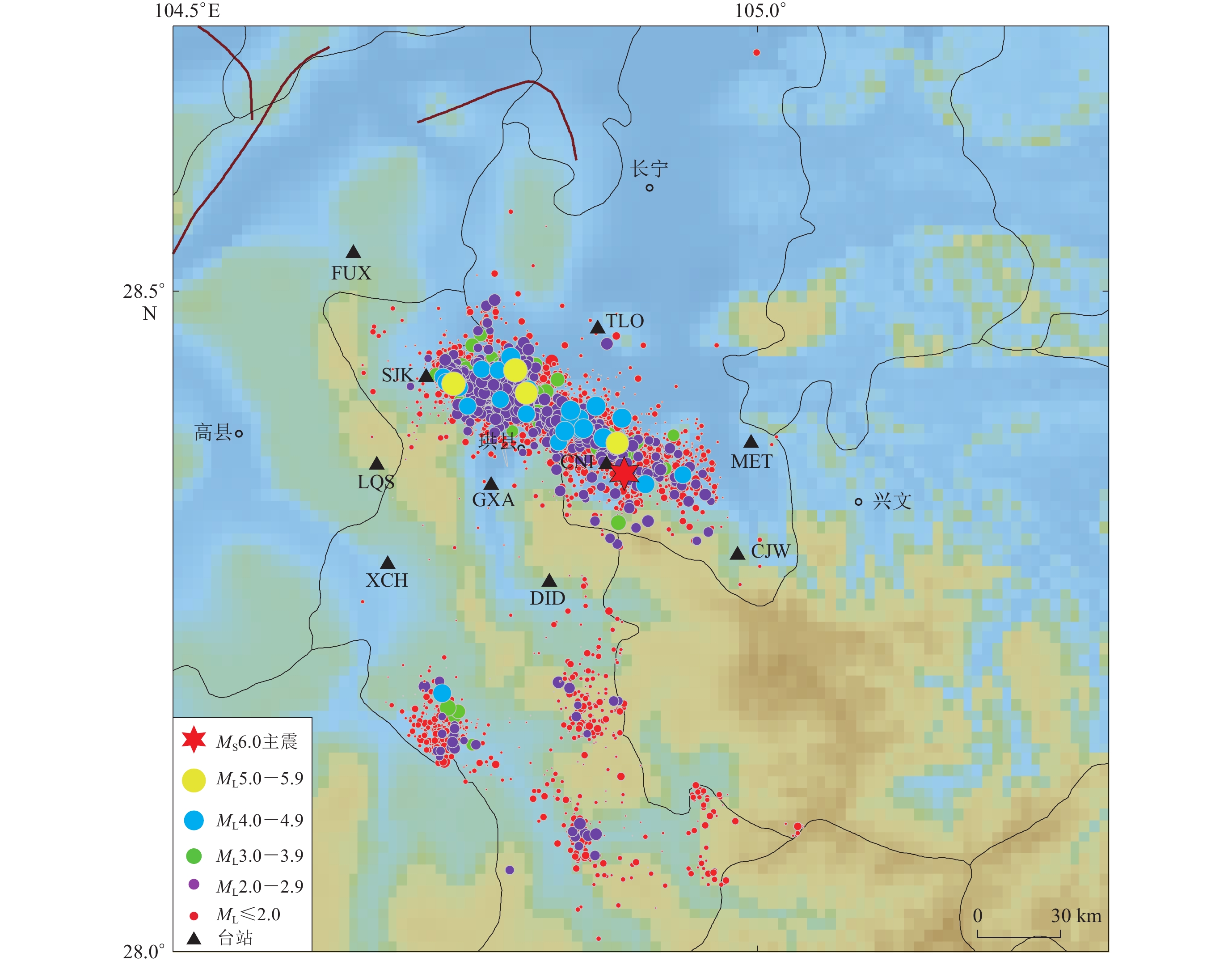
 下载:
下载:
